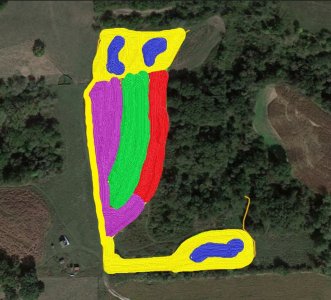williams111
5 year old buck +
I assume with a tree planter I could have all of the trees/shrubs planted in a few days? I dont think getting the switch going would be to bad.I like the proposed layout but it looks like a ton of work!
I've never dealt with switch but have heard others mention that you're going to want to burn it and having that many rows of other stuff in the middle of it might make that tough.
One thing I struggle with is when screening the perimeter of something like this - how to you discourage deer from bedding in the perimeter and looking out from it such that they would bust you? I wonder if just having miscanthus and not having conifers right up against it would help in that regard?
The switch maintenance does concern me. I mentioned that to the forester and he said there are other methods for managing it. I assume potentially discing or mowing? I will have to iron that out before implementing anything. Maybe like others have said, fewer wider strips of trees would be better? As well as make for larger blocks of switch which should be easier to manage.
I am concerned about bedding in the screening as well. The west edge of this piece is a gated and locked level C road. There is some traffic back there. I suppose worst case scenario they get bumped and run further into my property? I rarely come in from that side to hunt, because it requires an Easterly wind which we rarely get. The blind I put on the image is right on top of the hill. An east wind would blow downhill into the neighbors. I have access from all sides of the property and with such a small parcel I hunt very conservatively. Miscanthus on the outside of the switch might not be a bad idea instead of conifers.

